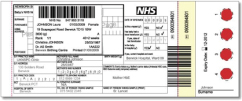Screening
Screening aims to identify unrecognized disease in apparently well people. Cost must be considered and balanced against that of treatment if the problem presents later. Conditions suitable for screening should:
- Be identifiable at a latent or early symptomatic stage
- Be treatable.
- Have a better prognosis if treated early.
Screening of newborns and children in the UK is outlined opposite and in the box below. Further information is available at http://www.screening.nhs.uk/england.
 | Notes |
| The midwife will collect bloodspots from the heel of every newborn baby on day 5–8 of life on to an absorbent card. These are analysed and also stored for further diagnostic tests if necessary | |
| Congenital hypothyroidism | Screen detects high TSH level but will miss hypothyroidism secondary to pituitary dysfunction. Thyroid replacement allows normal development |
 Sickle cell disease Sickle cell disease | Universal screening to all pregnant women aims to identify at-risk couples. Newborn blo odspots are analysed by HPLC for all sickle cell variants |
| Phenyketonuria (PKU) | A phenylalanine assay has replaced the original ‘Guthrie’ test. Babies PKU need urgent advice on starting a low-phenylalanine diet and long-term follow-up to prevent learning disability from phenylalanine metabolites |
 Cystic fibrosis (CF) Cystic fibrosis (CF) | A high immunoreactive trypsin (IRT) on the newborn blood spot is followed up with DNA testing for common CF mutations |
| Medium-chain acylcarnitine deficiency (MCAD) | A fatty acid oxidation defect that can lead to significant hypoglycaemia during periods of illness. Acylcarnitine abnormalities can be detected by tandem mass spectrometry. MCAD is a preventable cause of sudden death in infancy. Frequent feeds prevent the need for breakdown of fatty acids |
Genetic Disorders
Most disorders that are screened for in newborns have a genetic basis. Molecular genetic techniques are increasingly used to identify abnormal genes or chromosomes. It is vital that families receive appropriate counselling so that they understand the implications of an abnormal result. Genetic tests can be performed at various times:
- Pre-implantation testing is only available with in-vitro fertilization techniques, but can allow screening prior to implantation.
- Antenatal genetic testing via chorionic villus sampling or amniocentesis allows the possibility of termination of pregnancy. Some families choose to continue the pregnancy despite a positive result and this allows them time to come to terms with the diagnosis.
- Newborn genetic testing may be performed to confirm a clinical diagnosis (e.g. Down’s syndrome or congenital myotonic dystrophy) or following a positive screening test (e.g. CF gene testing following an abnormal IRT result on the newborn blood spot screen).
- Genetic testing of older children may be needed to confirm a diagnosis presenting later in childhood (e.g. fragile X or Duchenne muscular dystrophy). In general children must not be tested for adult-onset genetic disorders without their own informed consent unless it is going to alter their treatment during childhood.
Genetic Inheritance
Many genetic disorders occur sporadically with no preceding family history or are multifactorial, with an environmental element (e.g. diabetes), but some single-gene disorders show a clear inheritance pattern:
- Autosomal recessive: both parents carry an abnormal copy of the gene (carrier). 25% of their children will inherit both abnormal genes and be affected. 50% of offspring inherit one abnormal gene and are themselves carriers and usually unaffected. 25% of offspring do not inherit either abnormal gene.
- Autosomal dominant: inheriting even a single copy of the abnormal gene from either parent means the child is affected. These conditions sometimes present earlier or more severely in successive generations (anticipation). Sometimes the effect of a gene mutation will depend on which parent it is inherited from (imprinting).
- Sex-linked inheritance: gene disorders on the X chromosome usually only present in boys, as the presence of a second normal X chromosome in girls prevent them being severely affected. Examples include haemophilia A and fragile X syndrome.
- Chromosomal disorders: these are usually sporadic due to non-disjunction of chromosomes during meiosis (trisomy 21, 18 or 13) or due to rearrangement of major parts of the chromosome (translocations). In Turner’s syndrome there is deletion of one X chromosome (45 XO). In some cases there is deletion of part of a chromosome, e.g. cri du chat syndrome (5p- deletion).
Screening for Down’s Syndrome
Down’s syndrome affects 1 in 1000 live births (1 in 600 fetuses). There is an association with increased maternal age (1 in 880 at 30 years rising to 1 in 100 at age 40 years). 95% are due to non-disjunction during meiosis and 3% to an unbalanced translocation. 1% are mosaics, with only a proportion of cells within the body having trisomy 21. About 55% of affected fetuses are detected antenatally, through screening. In those diagnosed antenatally, only 5% of couples choose to continue with the pregnancy. Antenatal screening involves measurement of AFP, hCG and oestriol (the ‘triple’ test) and other markers, with nuchal fold (subcutaneous tissue at back of the neck) thickness in the fetus. This gives a calculated risk, which if high may prompt diagnostic testing via chorionic villus sampling or amniocentesis.
< div class='tao-gold-member'>



